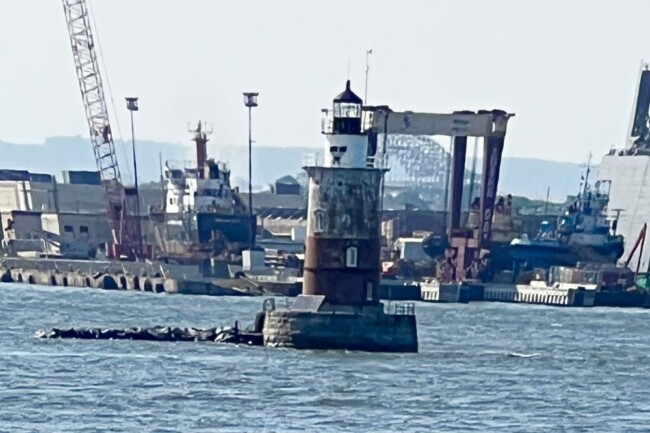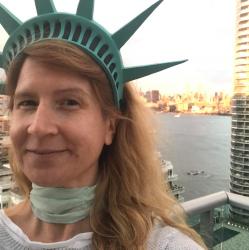On a small ridge of sand off the coast of Bayonne, in one of the most heavily used ports in the country, sits Robbins Reef Lighthouse. Some will know it as Kate’s Light for the brave woman who famously guided ships to safe passage through the Kill van Kull shipping channel, all as she raised two children in the wake of her husband’s death. Read on to learn about the dramatic life story hiding in an often unnoticed artifact of our maritime past.
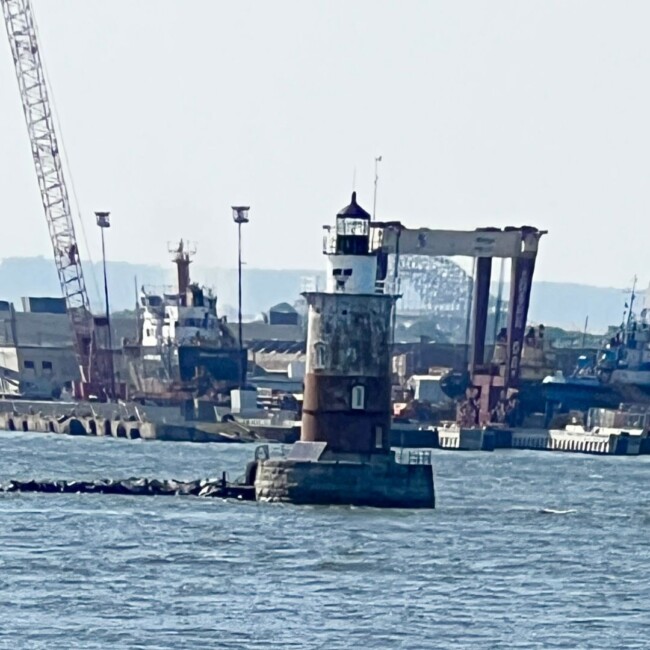
Humble but Historic
Passersby on the Staten Island Ferry typically only have eyes for Lady Liberty, bringing their cameras out just for her. Without knowing the history, few are likely to guess that a humble structure just south of the green goddess holds one woman’s story of love, adventure, and triumph over tragedy. Though in the National Register of Historic Places, Robbins Reef Lighthouse rarely shows up on lists of historical artifacts to note while touring New York Bay. It is located off Constable Hook in Bayonne, Hudson County, along the west side of the Main Channel of the Upper New York Bay. It is officially in New Jersey, but physically closer to the northern tip of Staten Island in New York. The name Robbins Reef comes from the 17th-century Dutch word rob or robyn which means seals.
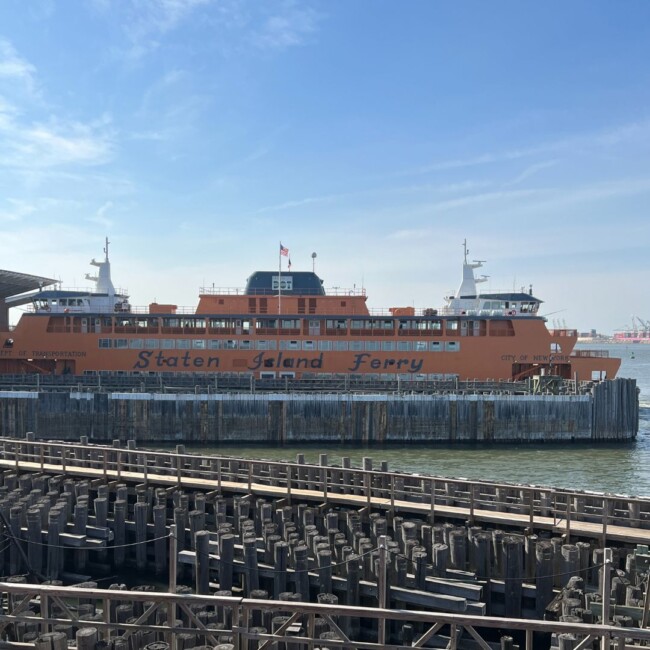
Robbins Reef is an offshore caisson or sparkplug lighthouse. Sparkplug refers to its shape with cast iron living quarters that sit on top of a granite foundation called a caisson. This type of lighthouse was developed in the late nineteenth century to hold up better in harsh weather than the more expensive-to-build, cottage-style, screw-pile lighthouses that they replaced.
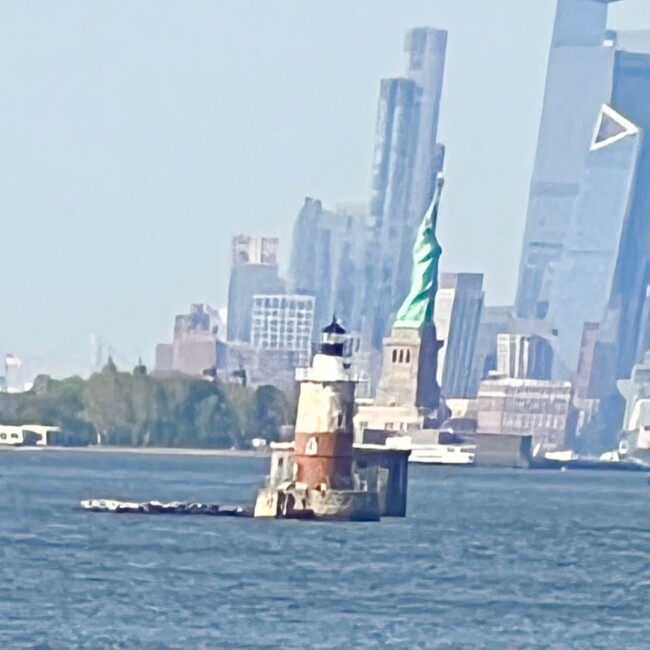
The Robbins Reef tower we see today was built in 1883 to replace an octagonal granite tower built in 1839. The original Robbins Reef light station was the first lighthouse built offshore in New York Bay. It was built to mark a dangerous rocky underwater ledge that had caused shipwrecks resulting in the death of sailors and passengers, along with substantial loss of cargo in America’s busiest harbor. Since it is out in open water, a mile away from shore, inaccessible by the roads or paths that coastal lighthouses typically claim, the keepers could only be reached by small boats. The resulting isolation must have seemed an irony when so near the country’s most bustling metropolis. The structure’s round four-story tower has living space that was meant for two people, but was the home for a family of four for one golden moment during the lighthouse’s use.
Read More: The Discovery of Hoboken: A Brief History
Meet Kate
Katharina Görtler married Joseph Kaird in 1875. Shortly after, they had a child and, shortly after that, Joseph died, leaving Katharina a widow and son Jacob without a father. In 1882, Katharina took her six year old son across the Atlantic Ocean to seek a better life than what she was able to procure for them in the quiet village of Rumbach, Germany. Upon arrival, the single immigrant mother found work as a cook in the Officer’s Quarters at Fort Hancock on Sandy Hook in New Jersey.
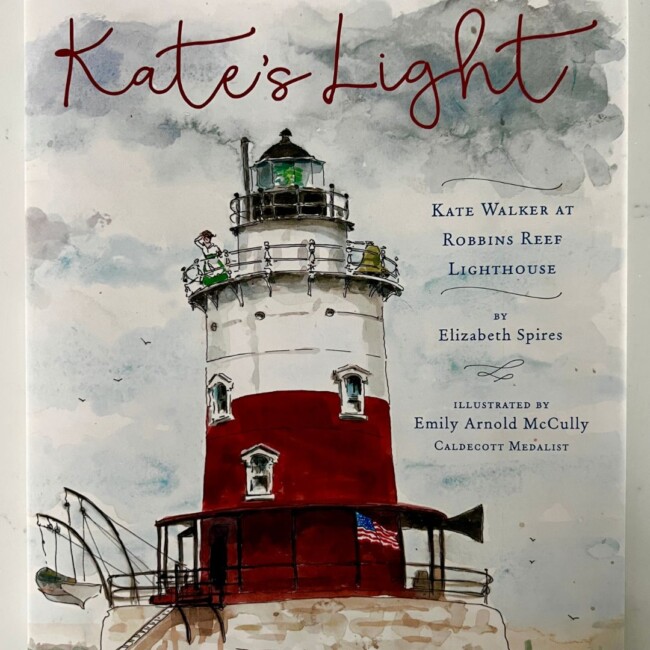
The Officer’s Quarters just happened to be where lighthouse keeper John Walker took his occasional meal. The two struck up a friendship that began with the retired sea captain, now lighthouse keeper, giving Katharina, now Kate, English language lessons. They wed in 1884 and settled as a family of three within the busy Sandy Hook Lighthouse where John was keeper. There they were able to keep a garden, and chickens, and to socialize with people who lived nearby. But an assignment to the Robbins Reef lighthouse would bring dramatic change to the lives of John and Kate Walker and to that of young Jacob.
In later interviews, when Kate was receiving her due from an admiring press, she admitted to having been far from happy about the change in their circumstances from living on land to being surrounded by water when the little family first moved to Robbins Reef. But the strange steep cylindrical house soon became a home, though one that required intense upkeep. A rowboat could be used to gather necessities from Staten Island. Jacob sometimes boarded with a family there so that he might attend school. In low tide, the family would make use of the sandy beach which suddenly surrounded them, providing a place to play and swim. A traveling library boat from the American Seaman’s Friend Society brought the family new books for them to read in the round, cozy parlor.
Kate applied for and received a paid position as assistant lighthouse keeper to her husband. And soon she gave birth to a second child — Mary, or Mae as she is referred to in the enchanting telling of their family story, Kate’s Light, by children’s book author Elizabeth Spires with beautiful illustrations by Emily Arnold McCully. The family of four seem to have found joy and peace together in their post.
Then, in 1886, with Mary only three, John died from pneumonia. His last words were, “Mind the light, Kate.” This proved a difficult promise for Kate to keep. The Lighthouse Board sent the newly bereaved family a notice that they had ten days to vacate Robbins Reef but then allowed her to stay on at a very low rate in a temporary position as they sought a man for the job.
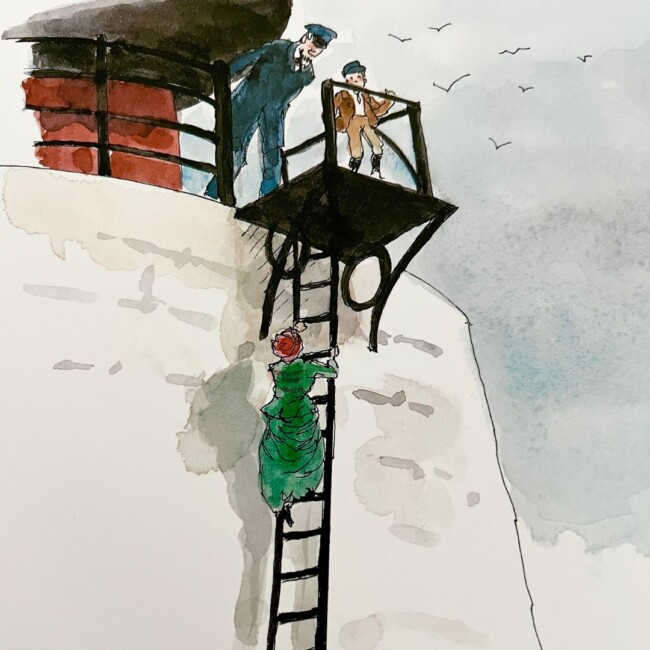
Despite the norms of the time, this 4’10” 100 pound woman broke the barriers within the male-dominated field of lighthouse keeping that attempted to shut her out. In 1890, she was appointed the official keeper of the light by President Benjamin Harrison. Kate stayed on as Robbins Reef lighthouse keeper for 33 years after her husband’s death, retiring on February 28, 1919. She is believed to have rescued 50 people from drowning, sometimes at great risk to herself, all while raising her two children.
In 1906, Kate would tell a New York Times reporter that there had been “as much housework to do here as at the Waldorf Astoria!” Along with maintaining the light and the foghorn she had to constantly scrape off the ice that would build up on the lantern room glass so that the light signal was visible to ships. If the foghorn machinery broke, she would have to ring a bell to alert someone from the Lighthouse Depot to come fix the equipment. If a disaster struck, she was to hang her American flag upside down. And yet, she did not retire from service by choice. When a new government mandate required all lighthouse keepers to retire by their 70th birthday, she was already 71.
Other Local Lighthouses to Love
The Sandy Hook Lighthouse is the oldest operating lighthouse in the United States, and it is open for visitors. It is located at the northern end of the Sandy Hook Unit of Gateway National Recreation Area. Amazingly well-preserved, this lighthouse that began its operation in 1764 is still in service. The National Park Service opens the lighthouse to the public on weekends for ranger-led tours,
See More: A Day Trip To Storm King Art Center in New Windsor, NY
The Navesink Light Station sits atop the Navesink Highlands, about two miles south of the Sandy Hook Lighthouse. It was established in 1828 and, in 1841, became the first lighthouse to use a Fresnel lens. The Fresnel lens is a lens designed to better reflect light that was designed in the 1830s and quickly became popular in lighthouse design. In 1862, the twin tower structure that is there now was completed. The lighthouse was decommissioned in 1949, but the twin towers continue to provide visitors with spectacular views. The Romer Shoal Light, another sparkplug lighthouse, is located just north of Sandy Hook.
In New York, the Coney Island Lighthouse sits at the western end of Coney Island where it has watched over Lower New York Bay since it was built in 1890. Lighthouse Hill in Staten Island is an idyllic neighborhood surrounded by Victorian homes, and is also the home to the Staten Island Range House lighthouse, which is still in operation by the Coast Guard.
The Absecon Lighthouse, built off the coast of Atlantic City in 1857, is New Jersey’s tallest lighthouse, at 171 feet. Today, the lighthouse is open to visitors to climb or to attend educational events or even to rent out for weddings. The lighthouse was recently restored and now includes a replica of the lightkeeper’s dwelling along with a Fresnel lens exhibit in an adjacent museum.

